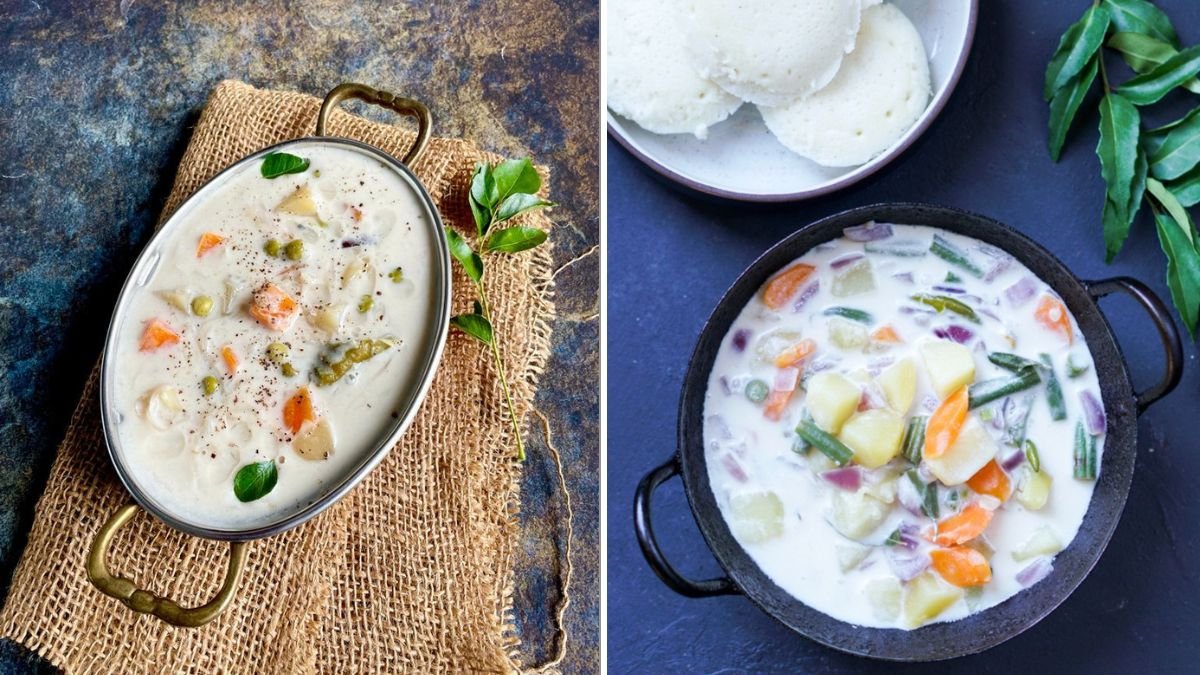Veg Stew with Coconut Milk is a classic, comforting dish popular in South Indian and Southeast Asian cuisines. Known for its creamy coconut flavor, aromatic spices, and wholesome vegetables, this stew is a perfect combination of taste and nutrition. Unlike heavier gravies, the light coconut-based broth enhances the natural flavors of the vegetables, making it a wholesome, healthy, and satisfying meal. With just a few simple steps, you can create a rich and flavorful veg stew right in your kitchen. This guide will show you 5 easy steps to make Veg Stew with Coconut Milk that’s both aromatic and delicious.
Ingredients You’ll Need
The key to a flavorful veg stew is using fresh vegetables, aromatic spices, and quality coconut milk. Here’s what you’ll need:
Vegetables (choose fresh and tender ones):
- 1 medium carrot, diced
- 1/2 cup beans, chopped
- 1/2 cup green peas
- 1/2 cup cauliflower florets
- 1 medium potato, diced
- 1/2 cup pumpkin or squash, diced (optional)
For the Stew:
- 1 medium onion, finely sliced
- 2–3 cloves garlic, minced
- 1-inch piece ginger, grated
- 2 green chilies, slit (adjust to taste)
- 1 teaspoon black peppercorns, slightly crushed
- 1 teaspoon cumin seeds
- 1–2 tablespoons coconut oil (or vegetable oil)
- 1/2 teaspoon turmeric powder
- 1 teaspoon salt (or to taste)
- 1–2 cups water or vegetable stock
- 1 cup coconut milk (full-fat for creaminess, or light for a lighter version)
- Fresh coriander leaves for garnish
Optional Additions for Extra Flavor:
- 1 sprig curry leaves
- 1 small cinnamon stick or cardamom pods
- 1 teaspoon roasted cashews or grated coconut for garnish
Having all ingredients ready ensures a smooth cooking process and a perfectly balanced stew.
Step 1: Preparing the Vegetables
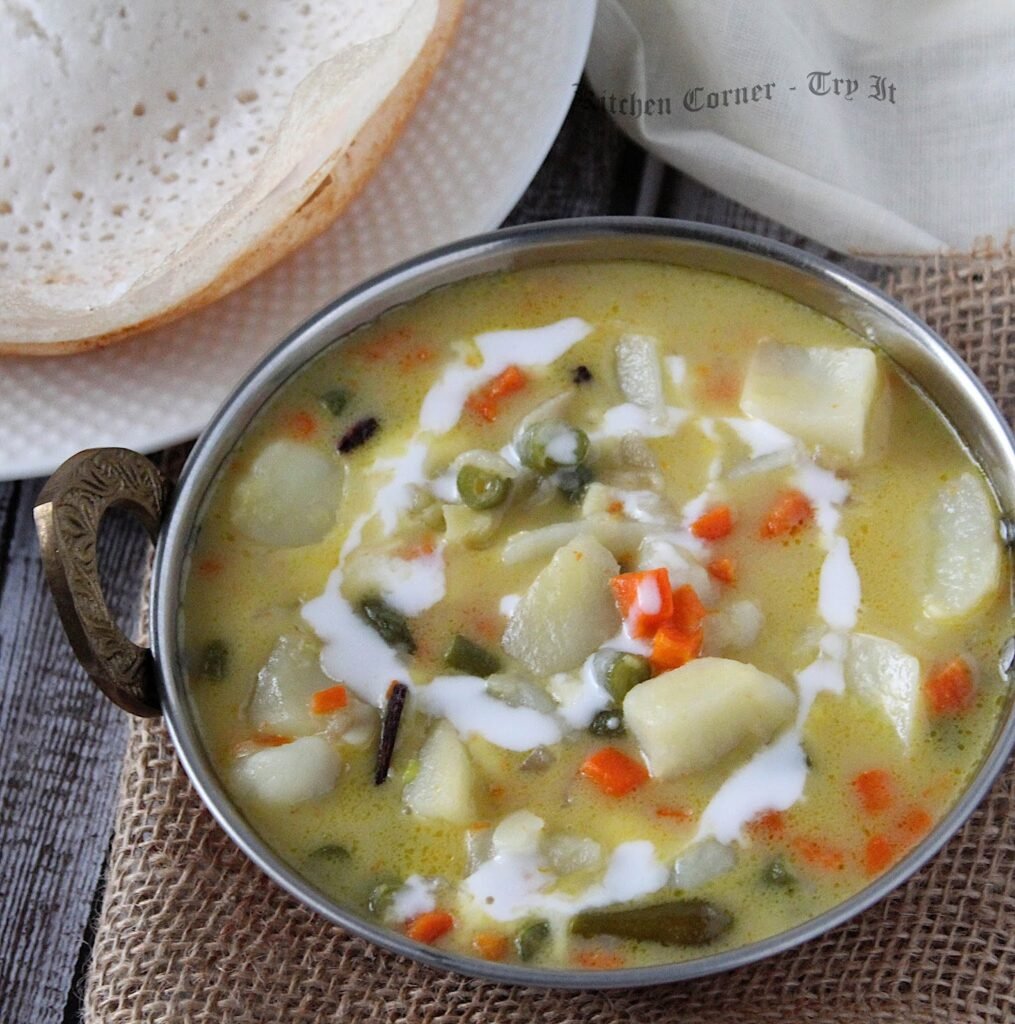
Proper preparation of vegetables ensures even cooking and preserves their color and texture.
Instructions:
- Wash, peel, and dice all vegetables uniformly.
- Hard vegetables like carrots, beans, potatoes, and pumpkin can be lightly parboiled for 3–4 minutes to reduce cooking time.
- Tender vegetables such as peas and cauliflower florets should be added later to avoid overcooking.
Tips:
- Use seasonal vegetables for the freshest taste and vibrant color.
- Uniform cuts help in cooking all vegetables evenly and make the stew visually appealing.
Step 2: Tempering Aromatics and Spices
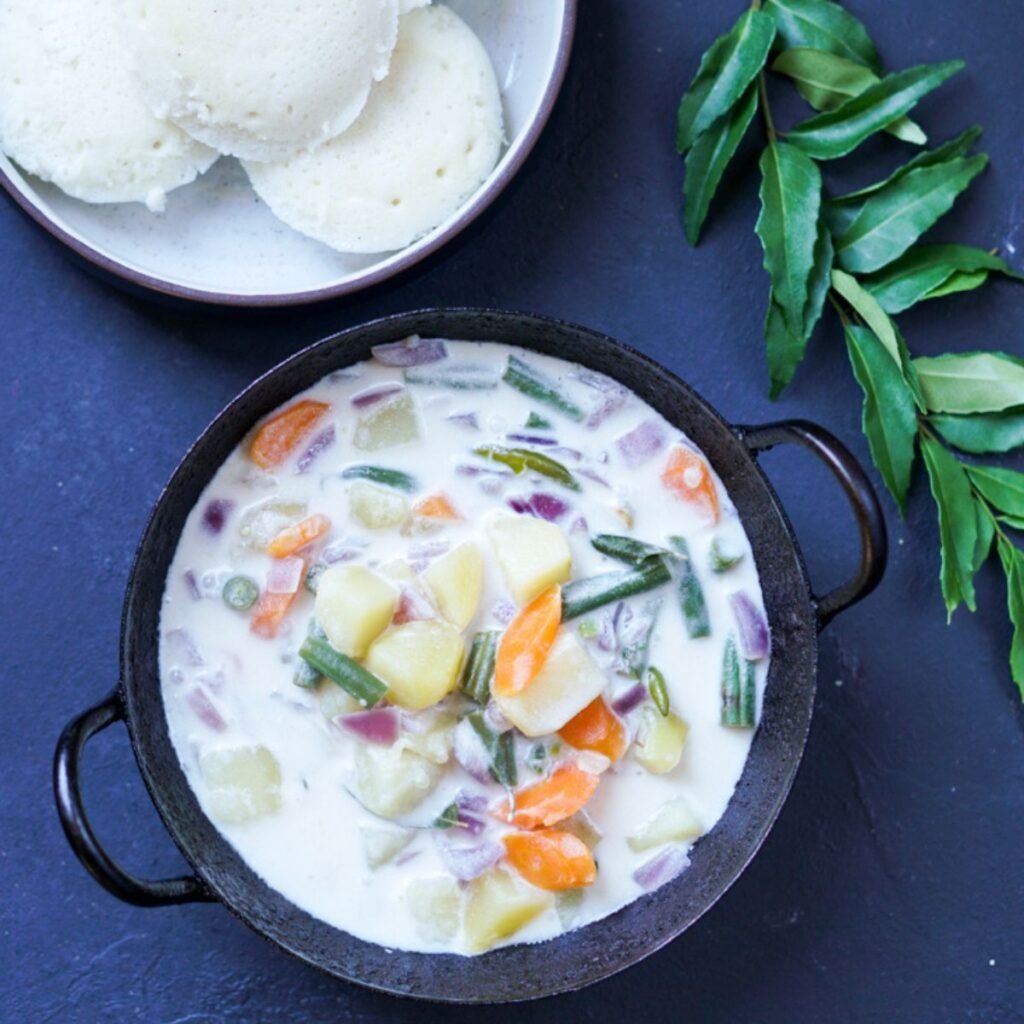
Tempering spices in hot oil or coconut oil releases their aroma and forms the base of the stew’s flavor.
Instructions:
- Heat 1–2 tablespoons coconut oil in a heavy-bottomed pan over medium heat.
- Add cumin seeds, black pepper, and optional whole spices like cinnamon or cardamom. Allow them to sizzle.
- Add minced garlic, grated ginger, and green chilies. Sauté for 1–2 minutes until fragrant.
- Add sliced onions and sauté until they turn soft and slightly golden.
Tips:
- Use medium heat to avoid burning the garlic and spices, which can make the stew bitter.
- Coconut oil enhances the authenticity and aroma of the dish.
Step 3: Cooking the Vegetables
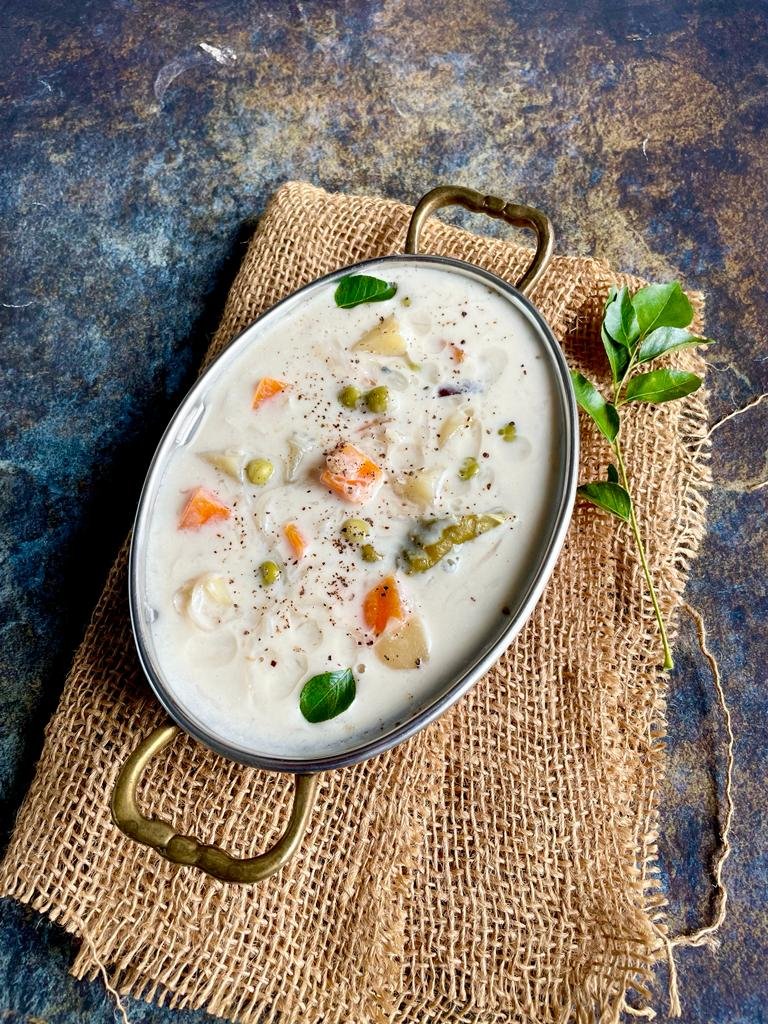
Once the aromatic base is ready, it’s time to add the vegetables and cook them in a light broth.
Instructions:
- Add diced hard vegetables first (carrots, potatoes, beans, pumpkin). Stir to coat with the tempered spices.
- Sprinkle turmeric powder and salt. Mix well.
- Pour in 1–2 cups of water or vegetable stock, ensuring vegetables are partially submerged.
- Cover and simmer on medium-low heat for 8–10 minutes, or until vegetables are tender but not mushy.
Tips:
- Do not overcook vegetables; they should retain their shape and slight bite.
- Adjust water quantity for desired broth consistency—more water for a soup-like texture, less for a thick stew.
Step 4: Adding Coconut Milk
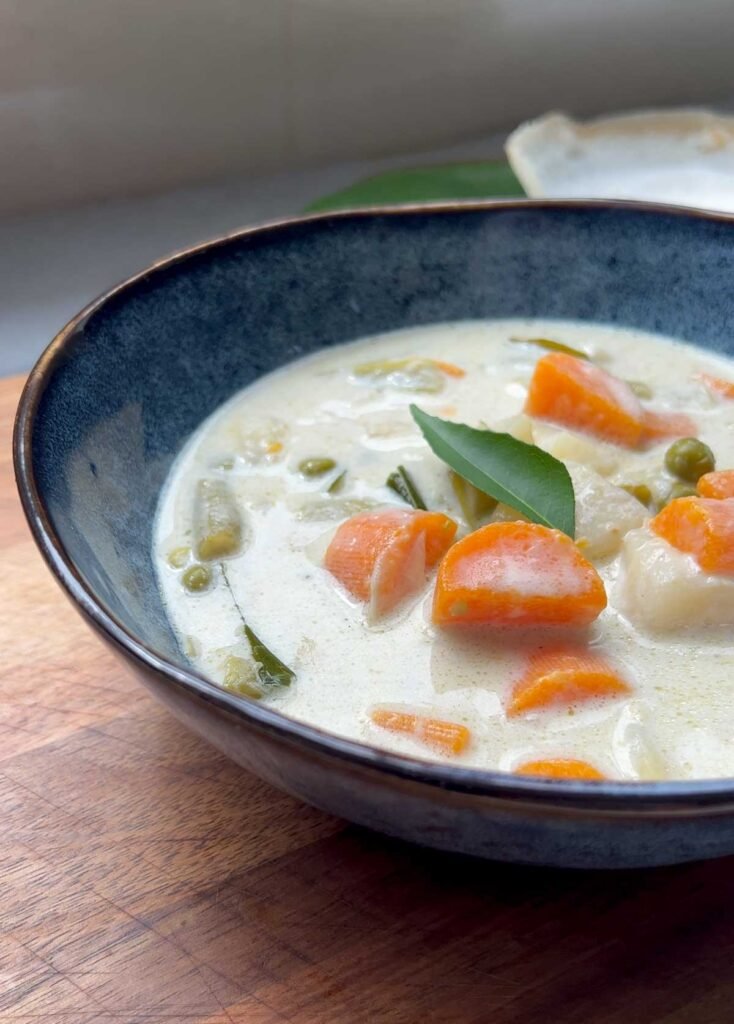
Coconut milk is what gives the veg stew its signature creaminess and subtle sweetness without being heavy.
Instructions:
- Lower the heat and add 1 cup of coconut milk gradually while stirring gently to combine.
- Let the stew simmer for another 5 minutes, allowing flavors to meld and the coconut milk to warm without boiling vigorously.
- Taste and adjust salt or spices as needed.
Tips:
- Avoid high heat after adding coconut milk, as it can curdle.
- Use full-fat coconut milk for a richer taste or light coconut milk for a healthier version.
Step 5: Garnishing and Serving
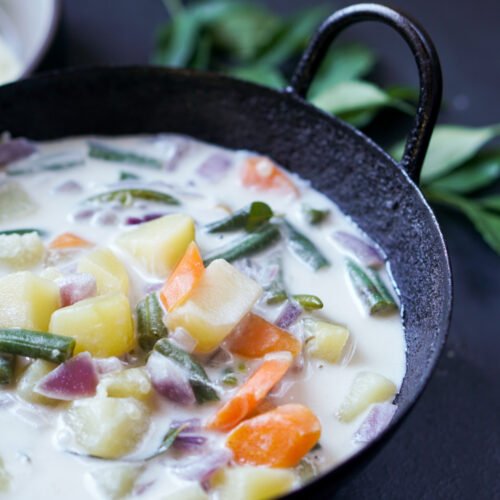
The final touches enhance the presentation and flavor, making the dish ready to serve.
Instructions:
- Turn off the heat and sprinkle freshly chopped coriander leaves on top.
- Optionally, garnish with roasted cashews, grated coconut, or a few curry leaves for added aroma.
- Serve hot with steamed rice, appam, idiyappam, or bread.
Tips:
- A squeeze of fresh lime juice can add a subtle tang to balance the sweetness of coconut milk.
- Serve immediately for the best flavor and texture.
Additional Tips for Perfect Veg Stew
- Use Fresh Coconut Milk: Fresh coconut milk provides the best aroma and creaminess compared to canned versions.
- Season Gradually: Taste as you cook and adjust salt and spices. Stews often require subtle adjustments toward the end.
- Balancing Flavors: Coconut milk naturally adds sweetness; balance with salt, green chilies, or a hint of black pepper.
- Variations: You can add tofu, mushrooms, or paneer cubes for protein-rich versions.
- Storage: This stew can be refrigerated for 1–2 days. Reheat gently on low heat to prevent curdling.
Health Benefits of Veg Stew with Coconut Milk
- Nutrient-Rich: A mix of vegetables provides vitamins, minerals, and fiber.
- Heart-Healthy: Coconut milk contains medium-chain triglycerides (MCTs) which may support metabolism.
- Digestive Benefits: Spices like ginger, cumin, and black pepper aid digestion and enhance flavor.
- Light and Satisfying: Unlike cream-based soups, coconut milk gives richness without heaviness.
Why This Veg Stew Is a Perfect Meal
Veg Stew with Coconut Milk is not only comforting but also versatile and healthy:
- It’s a one-pot meal packed with vegetables, spices, and protein (if paneer or tofu is added).
- The light, aromatic broth makes it perfect for breakfast, lunch, or dinner.
- It can be easily customized with seasonal vegetables, making it budget-friendly and nutritious.
- The creamy coconut base makes it appealing for kids and adults alike, without needing dairy cream.
Conclusion
Preparing Veg Stew with Coconut Milk at home is simple, nutritious, and incredibly flavorful. By following these five steps—preparing vegetables, tempering aromatics, cooking vegetables in broth, adding coconut milk, and garnishing—you can create a rich, comforting dish that’s perfect for any occasion.
The key to a perfect veg stew lies in balancing flavors, cooking vegetables to the right texture, and gently simmering coconut milk for creaminess. This dish is not only light and satisfying but also visually appealing with its colorful mix of vegetables.
Whether served with steamed rice, appam, or fresh bread, this stew is sure to delight family and friends. With minimal effort, you can enjoy a restaurant-style Veg Stew with Coconut Milk that’s both wholesome and indulgent—a perfect blend of health and flavor in every spoonful.
